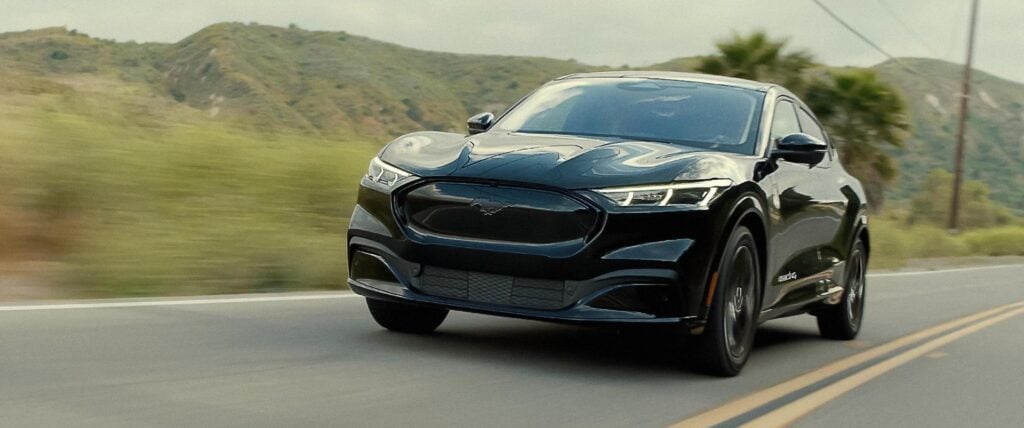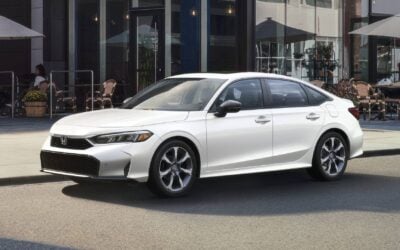The cost of buying a new car could soon get even higher. With tariffs on Canadian and Mexican auto imports set to take effect on March 4, new car prices in the U.S. are set to rise to new records. Here’s a look at how automotive industry analysts expect President Trump’s tariffs to impact U.S. car prices in 2025.
Tariffs on Canada and Mexico Take Affect March 4

President Trump has announced new tariffs on imported vehicles, car parts, and other goods will begin this month. Starting March 4, a 25% tariff on imports from Canada and Mexico will take effect, along with a 10% duty on imports from China. The administration claims the tariffs are intended to curb illegal drug trafficking and immigration. However, the move could severely disrupt the auto industry, where nearly 90% of vehicle exports from Mexico and Canada are destined for the U.S.
Industry experts are sounding the alarm. Flavio Volpe, president of Canada’s Automotive Parts Manufacturers’ Association, warns that the tariffs could bring auto production to a halt. “At 25%, absolutely nobody in our business is profitable by a long shot,” he said.
With supply chains at risk, U.S. automakers could feel the impact almost immediately. Car buyers in 2025 may need to act before MSRPs rise or adjust their budgets to account for potential price hikes. Here’s what drivers should know about the impact of tariffs on their wallet.
How Will Tariffs Affect Car Prices in 2025?
If fully enacted, the tariffs will add an estimated $60 billion in costs to the auto industry, according to AlixPartners research. Much of that cost is expected to be passed on to consumers. With the average new car price hovering near record highs, an extra $3,000 per vehicle could push some buyers out of the market entirely. In March 2025, the average new car price sits at $48,641. With the added costs of tariffs, new car prices are on track to surpass $50,000 for the first time.
For automakers, higher costs will likely result in production slowdowns and job losses. Manufacturing hubs in Detroit, Ontario, and across Mexico could see thousands of layoffs as companies struggle to absorb the added costs.
10% Tariff on Imports From China to Hurt American OEMs
President Trump’s decision to impose a 10% tariff on Chinese imports will have a limited direct impact on U.S. vehicle sales. However, the tariffs will significantly affect auto parts, potentially driving up already high vehicle prices for consumers. The impacts on auto parts are likely to drive auto insurance rates higher, too.
According to the U.S. International Trade Commission, the U.S. imports between $9 billion and $10 billion in auto parts and accessories each year.
Among automakers, Ford and General Motors will be the hardest hit. The biggest impact will be on Ford’s Lincoln Nautilus and GM’s Buick Envision. Together they made up 95% of the 88,515 China-made vehicles sold in the U.S. last year.
“It’s mainly GM and Ford that are really hit from a volume standpoint,” said Jeff Schuster, vice president of automotive research at GlobalData, in an interview with CNBC. “Our domestic guys are the ones taking the brunt of this, at least for full vehicles … but it can be muted to some extent.”
Volvo and luxury EV maker Polestar also produce vehicles in China, and will be subject to import tariffs. However, the impact of tariffs on Chinese imports will be small compared to that of the tariffs on goods from Mexico and Canada. According to GlobalData, new cars made in China represented just 0.6% of the roughly 16 million new vehicles sold in 2024 in the U.S.
Automakers Hit Hardest by Tariffs

If tariffs are fully enacted against imports from Mexico and Canada, Automotive News reports that several automakers will be affected. A few big American automakers will face rising costs from the new 10% tariff on imports from China. These are the cars likely to see rising prices due to tariffs in 2025:
Audi: Volkswagen Group’s Audi plant in Mexico builds the Audi Q5. The factory produced nearly 176,000 cars in 2023, many of which were exported to the United States.
BMW: The BMW plant in San Luis Potosi, Mexico produces the 3 Series, 2 Series Coupe, and M2, with nearly all output going to the U.S.
Ford: With three plants in Mexico, Ford exported nearly 196,000 vehicles to the U.S. and Canada in the first half of 2024 alone, with 90% of those going to the U.S. Ford also has a plant in Oakville, Canada. The Detroit automaker will also be impacted by the 10% tariff on imports from China. The Lincoln Nautilus luxury SUV is manufactured in China, and will be subject to new import tariffs.
General Motors: GM imported roughly 750,000 vehicles from Canada and Mexico in 2024. This includes key models like the Chevy Silverado, GMC Sierra, and electric versions of the Equinox and Blazer. GM’s Buick Envision is largely manufactured in China. Envisions that are destined for the U.S. market will be subject to the new 10% tariff on imports from China.
Honda: 80% of Honda’s Mexican-made vehicles are exported to the U.S. and has warned that continued tariffs may force a production shift.
Kia: Under the Hyundai Motor Group umbrella, Kia operates a Mexican factory producing its own vehicles and some Hyundai Santa Fe SUVs.
Mazda: In 2023, Mazda exported around 120,000 vehicles from Mexico to the U.S. Mazda has suggested that it may reconsider future investments due to U.S. tariffs.
Nissan: Nissan manufactures the Sentra, Versa, and Kicks in Mexico, with nearly 505,000 vehicles built in the first nine months of 2024.
Stellantis: FCA (now under Stellantis) operates assembly plants in Saltillo, Mexico (Ram pickups and vans) and Toluca, Mexico (Jeep Compass). Stellantis also has plants in Ontario, Canada.
Toyota: In 2025, Toyota builds its Tacoma pickup truck exclusively in Mexico, selling more than 230,000 units in the U.S. in 2023.
Volkswagen: VW Group operates a large factory in Puebla, Mexico. This is where VW produces the Jetta, Tiguan, and Taos for U.S. export. In Canada, VW is investing $4.9 billion to build a battery factory in St. Thomas, Ontario, set to start production in 2027.
What Tariffs Means for Car Buyers
With new vehicle prices already at historic highs, adding another $3,000 to the price tag could drive even more consumers toward used cars or force them to hold onto their vehicles longer. Dealers may also see a slowdown in sales as affordability becomes a growing concern.
Automotive repair costs will feel the impacts of the new 10% tariff on certain imports from China. Many electrical component for today’s collision repair are sourced from the Chinese market. As a result, auto insurance premiums are set to rise in 2025.
A Blow to the Auto Industry
The auto industry is one of the most interconnected sectors in North America. Car parts often cross borders multiple times before a final vehicle reaches the consumer. The new tariffs disrupt decades of trade agreements and could lead to long-term shifts in manufacturing.
While some automakers, like BMW, have committed to continuing investment in Mexican production, others are scrambling to adjust supply chains. In what could be a longer-lasting impact, some are reevaluating their manufacturing strategies.
Trump has suggested that the tariffs will push automakers to bring production back to the U.S. However, industry experts argue that shifting manufacturing isn’t so simple. Building new plants and establishing new supply lines takes years. In the meantime, consumers are the ones who will feel the pinch.
General Motors, Ford, and other automakers have already stated that they won’t move production unless they see clear long-term benefits. Instead, they intend to mitigate the immediate impact of tariffs through supply chain adjustments and pricing strategies.
The Bottom Line for Car Shoppers
Tariffs on auto imports from Canada, Mexico, and China are likely to send car prices higher in 2025. This all comes at a time when new car prices are already near all-time highs. If you’re in the market for a new car, staying informed and being strategic could save you thousands.
CarEdge’s Take: If you’re considering buying any car in 2025, it’s worth watching how these tariffs play out. If prices rise sharply, buyers may want to consider negotiating harder on new cars, exploring used car options, or waiting for potential policy changes.
CarEdge will continue to track these developments and provide insights on how they affect car prices, financing, and buying strategies. For the latest updates and money-saving tips, check out our free car buying tools and expert analysis.













How do you think this could affect the leasing market? We’re back and forth right now on purchasing a used car vs leasing a new car
I don’t understand why the automakers don’t just add the additional cost of tariffs to the Monroney sticker as a separate line item so the buyer can make an informed decision on whether or not to buy the vehicle.